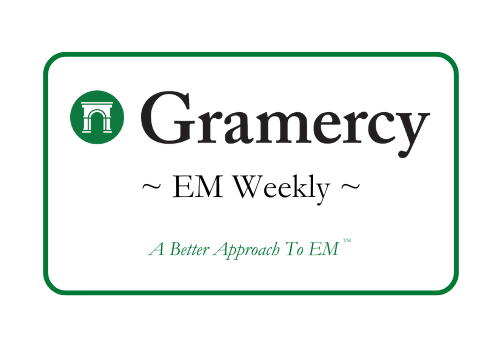Contents
Market Overview
Macro Update
The events of “Liberation Day” on April 2nd have introduced a disruptive new phase for global markets, as the U.S. administration unveiled a complex web of tariffs targeting its trade partners. These tariffs, calculated on a ratio of each country’s trade surplus with the U.S. to its total exports to the U.S., are further compounded by a uniform 10% baseline tariff. If the proposed tariffs remain in place, preliminary calculations suggest that the average effective tariff rate in the U.S. economy could rise to approximately 25%, a level not seen since the 1880s. While this new policy is positioned as a move to address perceived imbalances in trade, the implications for the broader U.S. economy are material. The base case for the U.S. now points to a potential recession, while a stagflationary environment—marked by stagnating growth and rising inflation—is also a significant probability.
The ripple effects on the global economy, particularly on emerging markets, will largely depend on the response from key trading partners such as China and Europe. On Friday, China retaliated with tariffs of 34% on all U.S. goods, escalating concerns of a full-scale global trade war. However, there remains the potential for bilateral negotiations with U.S. trade partners that could result in a partial rollback of tariffs, thereby stabilizing the outlook.
Following “Liberation Day”, risk assets faced a broad-based selloff. U.S. assets, particularly equities, underperformed compared to their non-U.S. counterparts, as growth expectations for the U.S. were further downgraded. The S&P 500, Nasdaq, and Dow Jones were all down between 6% and 9% for the week. Year-to-date, these indexes are now down 12%, 19%, and 8%, respectively. Concerns over U.S. growth also contributed to a decline in the U.S. dollar, with the DXY falling to 102. The yield on the 10-year U.S. Treasury bond dropped by around 30bps, ending the week at 3.9%, dipping below the 4.0% threshold for the first time since September 2024. The market is now pricing in four rate cuts; however, the Fed outlook has become more complicated as Federal Reserve Chair Jerome Powell confirmed in statements Friday that “tariffs could have a persistent inflation impact.”
Amid the market volatility and the weakening macroeconomic outlook, OPEC+ made a larger-than-expected increase in oil production, negating the oil rally that had been underway since early March. Brent crude closed the week down around $10, falling below $65 per barrel for the first time since August 2021. Gold surged to new highs, reaching $3,100 per ounce, reflecting heightened demand for safe havens.
The rest of the week’s economic data unfolded against the backdrop of “Liberation Day”. March’s non-farm payrolls surprised to the upside, coming in at 228,000 vs. the consensus estimate of 140,000. However, the market largely shrugged off this positive surprise, as it seemed backward-looking amid the new economic environment created by the tariff policies. Earlier in the week, the JOLTS report signaled signs of a cooling labor market, and both the ISM manufacturing and services indexes showed signs of faltering. Given the worsening forward-looking data, Fed officials have emphasized that they will closely monitor for signs that tariffs are contributing to persistent inflationary pressures.
Elsewhere, the Chinese March manufacturing and services PMI data came in stronger than expected, signaling a potential rebound in economic activity. In Europe, the preliminary March CPI figures met expectations, with increases of 0.6% month-over-month and 2.2% year-over-year. However, Germany’s factory orders failed to meet expectations, underscoring the weakness in the industrial sector even before the impact of President Trump’s tariff policies, and raising doubts about the strength of a potential recovery in German industry.
On the geopolitical front, EU defense ministers met in Warsaw and NATO foreign ministers convened in Brussels to discuss a “roadmap” for shifting the defense burden back to Europe. However, their challenge is how to do so without creating vulnerabilities that could be exploited by Russia.
As markets react to the unfolding economic landscape, the key question has become how long these U.S. policies can be sustained without tipping the balance toward a deeper global economic slowdown. The next few weeks will be critical in determining whether the tariff policies will be recalibrated or if they will persist, adding new dimensions of risk to both the U.S. and the global economy.
EM Credit Update
Against this turbulent macro backdrop, EM fixed income markets were relatively resilient. EM hard currency sovereigns were down only 0.02% and EM hard currency corporates were up 0.07%. This compares favorably to other risk assets, including U.S. equities mentioned above, as well as to U.S. high yield credit which was down 0.7% this week. From a spread perspective, sovereigns and corporates performed in line, widening by 21bps and 28bps, respectively. Decompression was a theme for the week as high yield underperformed investment grade. For sovereigns, high yield spreads widened 38bps versus only 8bps for investment grade. For corporates, high yield spreads widened 42bps versus 22bps for investment grade. Surprisingly, EM local currency sovereign bonds outperformed this week, gaining 1.54%, as markets focused on the greater prospect of a U.S. recession vs. a broader global slowdown.
In the hard currency sovereign space, Sri Lanka, Mongolia and Iraq underperformed, the first two in the context of U.S. tariffs and Iraq amid the sharp oil sell-off. Outperformers were Venezuela and Ecuador, as highly idiosyncratic/distressed stories were relatively shielded, for now, from the overall tariff-induced market declines.
Primary market activity was muted, unsurprising among all the volatility. China issued CNY-denominated sovereign bonds; there were only 11 corporate deals, mostly in Asia.
The Week Ahead
The main market focus will be digesting U.S. tariffs and any signals in terms of global trade war escalation or de-escalation. The U.S. 10% baseline tariff on imports from all countries is due to take effect over the weekend. Higher bilateral tariffs on more than 50 countries will take effect Wednesday, April 9th.
EU trade ministers will meet in Luxembourg to discuss next steps on U.S. tariff response. Their finance minister colleagues will hold an informal meeting in Warsaw, joined by central bank governors including ECB President Christine Lagarde. FOMC minutes from the March 18th-19th policy meeting will be released. The Reserve Bank of India is expected to cut its main policy rate by 25bps to 6.0%, as is the Reserve Bank of New Zealand. Central bank rate decisions are also due in Israel, Romania, Kenya, Uruguay, Peru, and the Philippines. A slew of CPI data for March, including from the U.S., Colombia, Chile, Indonesia, Mexico, China, Argentina, Brazil, Germany, and Spain will also be released next week.
Other interesting data will include Bank of Canada’s business outlook, China forex reserves, eurozone retail sales, Germany industrial production and trade, Japan current account, China PPI and CPI and UK industrial production. The week will wrap up with the University of Michigan consumer sentiment survey in the U.S.
Fixed Income

Equities
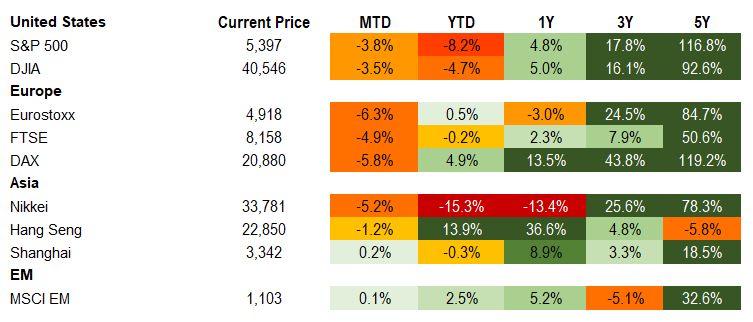
Commodities

Source for data tables: Bloomberg, JPMorgan, Gramercy. EM Fixed Income is represented by the following JPMorgan Indicies: EMBI Global, GBI-EM Global Diversified, CEMBI Broad Diversified and CEMBI Broad High Yield. DM Fixed Income is represented by the JPMorgan JULI Total Return Index and Domestic High Yield Index. Fixed Income, Equity and Commodity data is as of April 4, 2025 (mid-day).
Country Highlights
United States Upends Trade Policy, Driving Volatility and Uncertainty
Event: President Trump announced reciprocal tariffs, ranging from 10% to 50%, on countries around the world and reiterated global tariffs on automobiles and parts that were previously announced. As mentioned above, the average effective tariff rate in the U.S. economy could rise to approximately 25%.
In EM, the new tariff rates are most aggressive on imports from Asia, particularly China and Vietnam, and are less aggressive on those from Latin America. U.S. stocks sold off on growth concerns, contributing to dollar weakness. European stocks and the euro strengthened, despite the bloc being hit with a 20% tariff, blunting the initial impact on EM foreign exchange. By the end of the week, China retaliated with a proportional 34% tariff on its imports from the U.S., as well as with a mix of other measures, including export controls, anti-dumping probes, and import restrictions on poultry. China also put American defense companies on an “unreliable entity” list.
Gramercy Comment: The far-reaching direct and indirect effects of the dramatic shift to protectionist U.S. trade policy is a blow to globalization and increases the chances of a U.S. recession. Uncertainty is high and transmission mechanisms may not necessarily be obvious or linear given many moving factors. The scope and duration of U.S. economic weakness, combined with prospects for the rest of the world to offset the growth drag, will in part determine if dollar depreciation persists.
Following the tariffs, small open economies with limited policy space remain among the most vulnerable. In China, however, we expect authorities to augment support as needed to offset weakness as they aim to achieve their around 5% growth target this year. However, they will be doing so in the face of persistent structural challenges.
While Mexico does not face a new reciprocal tariff, the country’s significant economic linkages with a likely weaker U.S. economy, combined with the previously announced tariffs, continue to place downside pressure on Mexico’s growth forecasts. For now, the Bank of Mexico continues to have space to cut rates amid high real rates and a weak dollar. Markets will watch for additional sector tariffs following completion of the Section 232 investigations and country retaliations. The focus will also be on potential off-ramps and negotiations to lower tariffs, albeit with a low level of trust between the targeted countries and the U.S.
China’s most recent retaliation is a step-up from its more targeted and limited response to the initial round of tariffs in the first quarter and runs the risk of further escalation. We think Mexico remains best positioned for a negotiated off-ramp given the current exemptions under USMCA and the upcoming renewal process. However, we still expect an uncertain and noisy path.
Emerging Markets Technicals
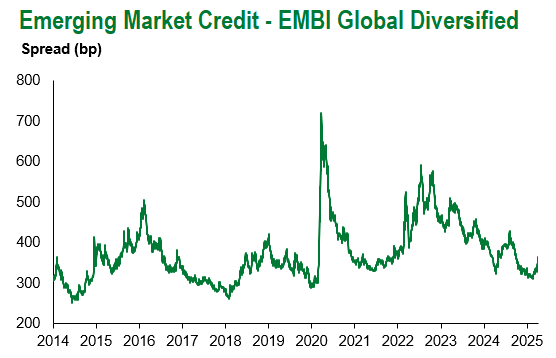
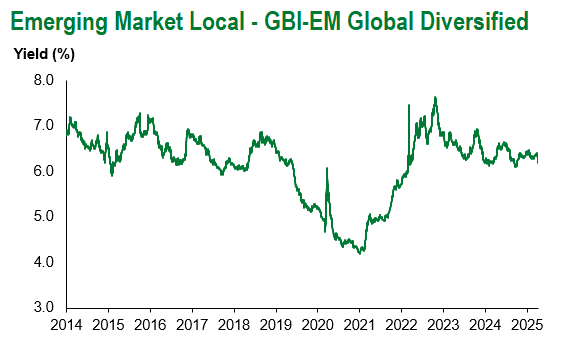
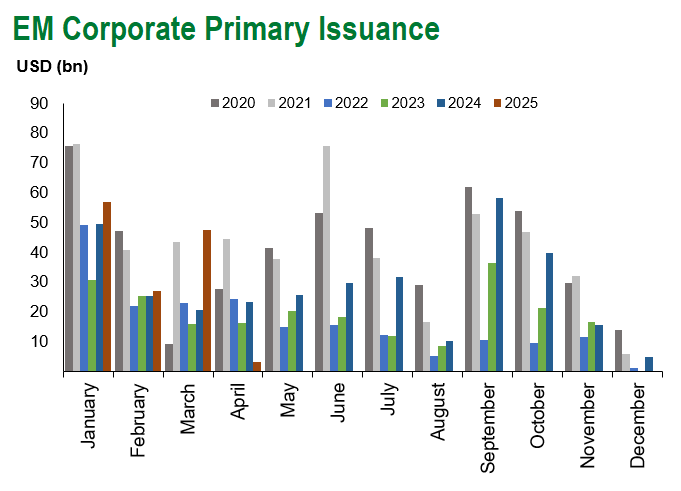

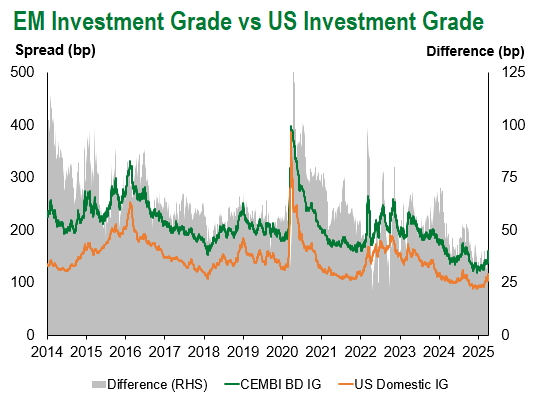
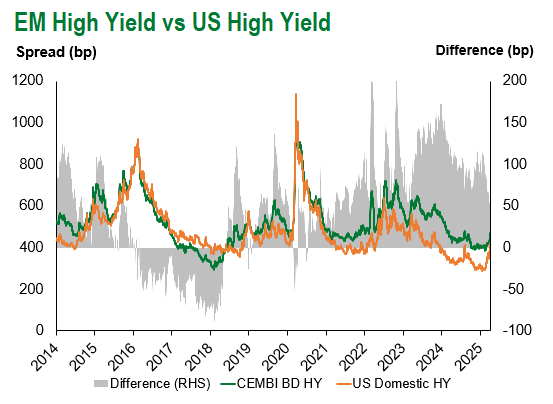
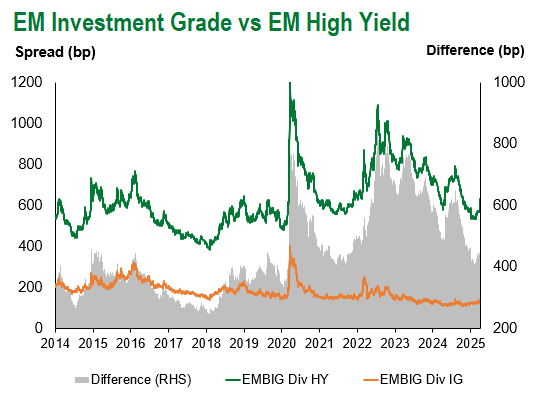
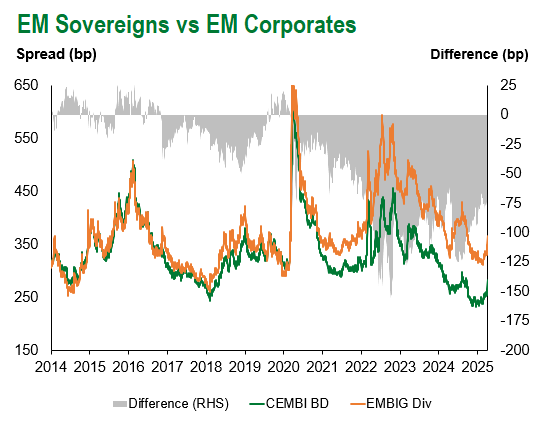
Emerging Markets Flows
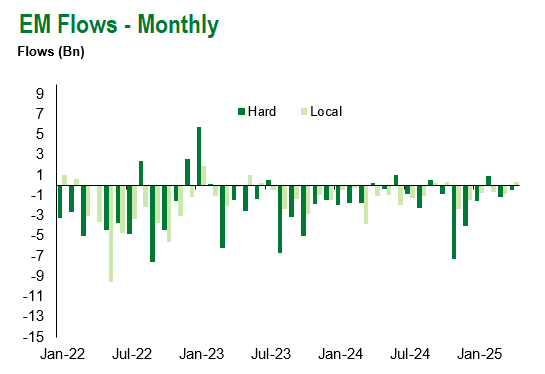
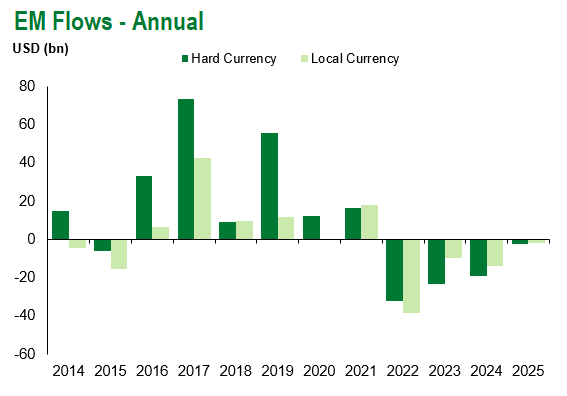
Source for graphs: Bloomberg, JPMorgan, Gramercy. As of April 4, 2025.
For questions, please contact:
Kathryn Exum, CFA ESG, Director, Co-Head of Sovereign Research, [email protected]
Petar Atanasov, Director, Co-Head of Sovereign Research, [email protected]
This document is for informational purposes only. The information presented is not intended to be relied upon as a forecast, research or investment advice, and is not a recommendation, offer or solicitation to buy or sell any securities or to adopt any investment strategy. Gramercy may have current investment positions in the securities or sovereigns mentioned above. The information and opinions contained in this paper are as of the date of initial publication, derived from proprietary and nonproprietary sources deemed by Gramercy to be reliable, are not necessarily all-inclusive and are not guaranteed as to accuracy. This paper may contain “forward-looking” information that is not purely historical in nature. Such information may include, among other things, projections and forecasts. There is no guarantee that any forecasts made will come to pass. Reliance upon information in this paper is at the sole discretion of the reader. You should not rely on this presentation as the basis upon which to make an investment decision. Investment involves risk. There can be no assurance that investment objectives will be achieved. Investors must be prepared to bear the risk of a total loss of their investment. These risks are often heightened for investments in emerging/developing markets or smaller capital markets. International investing involves risks, including risks related to foreign currency, limited liquidity, less government regulation, and the possibility of substantial volatility due to adverse political, economic or other developments. References to any indices are for informational and general comparative purposes only. The performance data of various indices mentioned in this update are updated and released on a periodic basis before finalization. The performance data of various indices presented herein was current as of the date of the presentation. Please refer to data returns of the separate indices if you desire additional or updated information. Indices are unmanaged, and their performance results do not reflect the impact of fees, expenses, or taxes that may be incurred through an investment with Gramercy. Returns for indices assume dividend reinvestment. An investment cannot be made directly in an index. Accordingly, comparing results shown to those of such indices may be of limited use. The information provided herein is neither tax nor legal advice. Investors should speak to their tax professional for specific information regarding their tax situation.
